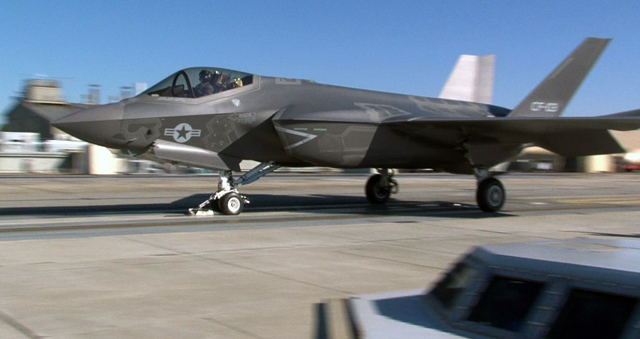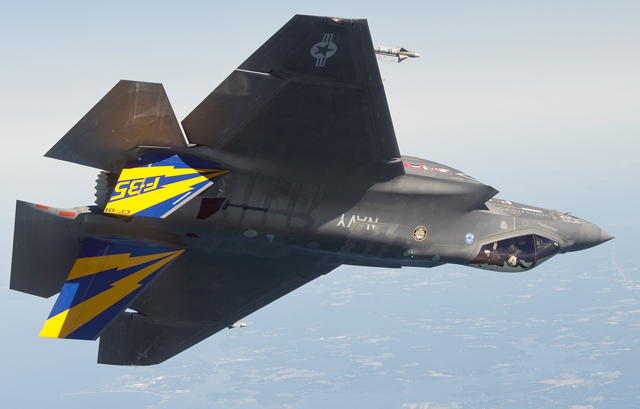The Naval Sea Systems Command (NAVSEA) is working hard to integrate the Lockheed Martin F-35C Joint Strike Fighter onto the carrier deck, but challenges remain.
Aircraft carriers, by virtue of their huge size and capability, are adaptable overtime, says Rear Admiral Thomas Moore, the US Navy's programme executive officer for carriers. An individual carrier will repeatedly adapt new aircraft over the course of its lifetime and the F-35C will be no different.
"While the Joint Strike Fighter presents its own set of challenges, it's not something we haven't done before," Moore says.
 |
|---|
USN |
The biggest single hurdle the USN must overcome is the size of the Pratt & Whitney F135 afterburning turbofan. "The engine itself is probably the biggest challenge we have from a logistical footprint because the engine is so big," the Admiral says.
The 100,000 ton Nimitz-class nuclear-powered carriers are not currently configured to underway replenish an engine of that size. As such, the giant vessels will have to be modified to accommodate the F135. The Military Sealift Command's cargo ships will also need to be modified to carry the F135. But the new Gerald Ford-class carriers are being designed from the outset with the ability to accommodate the massive engine.
The F135 will be shipped broken down into several modules, but it might have to be broken down further for transportation during operations at sea, Moore says. In the interim, the USN will use Bell-Boeing V-22s and Sikorsky CH-53s to move the engine between ships. But it may be a moot point.
"By the time we actually get the F-35C introduced out to the fleet, I suspect the majority of the carrier are going to have that capability installed," Moore says. "Eventually all of them will."
The USN has never operated a stealth aircraft from a carrier deck before, but Moore says he expects that maintaining the F-35C low observable coatings should not be a problem. The USN has developed processes to do the necessary repair work on the carrier's hanger deck without specialized facilities.
"The plane was designed so that the low observable things could be worked on and maintained by the crew itself," Moore says. "Similar to when we went from the [Grumman F-14] Tomcat to the [Boeing F/A-18E/F] Super Hornets."
Unlike the aluminum-skinned F-14 or classic F/A-18A/B/C/D, the Super Hornet is built largely of composite materials. The move to composite material required a complete reworking of the USN's maintenance processes onboard the carrier, Moore says. Similar changes of will be required for when F-35C becomes operational with the USN-particularly with regard to the JSF's Autonomic Logistics Information System (ALIS).
Further, there is no intermediate level of maintenance on the F-35. Therefore, frontline maintenance will be done on the carrier while more complicated maintenance will be done by the original equipment manufacturer, Moore says. While there might be some maintenance facilities needed specifically by the F-35, there will not be specialized facilities needed for low observables repairs. If there is a major defect in an F-35C's coatings, the aircraft will have to be returned to Lockheed for repairs.
 |
|---|
USN |
Carriers will also need to have a dedicated storage facility to stow lithium-ion batteries, which are not used on other naval aircraft, Moore says. Lithium-ion batteries are more volatile than the other battery types used by the USN, and as such, require special handling. "Lithium-ion batteries are very challenging to handle, so you have to be very careful," he says.
The rest of the F-35C integration issues are relatively simple, Moore says. The aircraft needs 270 volt direct current, which means the carrier's electrical servicing stations will need to be tweaked.
Additionally, the carrier's jet blast deflectors will need to be modified, he adds. Some of the cooling panels will have to be modified with different materials and there will need to be increased cooling via sea-water pipes. But Moore says the modification are not particularly challenging. "It's the same issue we went through with the Super Hornet," he says.
There will also need to be storage for some of the F-35's unique weapons which are not used on other naval warplanes, Moore says. "It's a relatively simple matter," he says.
Aside from the physical integration with vessel, the F-35 generates a lot of classified data. "We'll have to configure a lot of the ready rooms with secure tactical briefing rooms," Moore says.
Overall, Moore says that integrating the F-35C onboard ship is no different than integrating any other aircraft.
Source: Flight International


























